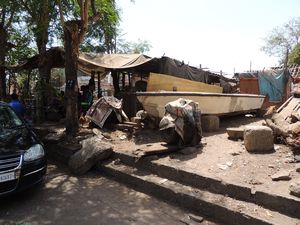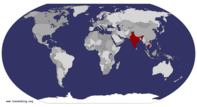Advertisement

 Fishermans village
Fishermans village
Another area that was attacked by terrorists in 2008, also where the majority of the market seafood comes inI am right in the middle of that fantastic (and HUGE) book Shantaram, which as I am sure a lot of you know plays out in India’s financial capitol of Mumbai India (formerly know as Bombay). 14 million people strong, with about 800,000 of them living in Asia’s largest slum Dharavi, Mumbai is a kaotic mashing of culture, religion, poverty, history and deep seeded values that predate any western way of life. The air is thick with a modern India and contrasts are everywhere.
Stepping off the plane I felt I had no idea what to expect or what I was walking into. As with many of the cities we have ventured too there is always this day or two of unfamiliarity as you walk the streets and learn what is what and where. Here in Mumbai, as with most places in India, it feels like no matter which way you turn there is always something around each corner that opens your eyes just that much more. For me it’s the level of poverty, and from what I have learned the almost denial that it exists. A cast system that is very evident and hard to understand.
We chose to stay in the Kar Danda area, which is west of the airport, south of the more popular Coloba area and offered a good mix of local immersion and some luxuries (like a modern coffee shop and restaurants offering some western foods). Walking down the streets we where able to really grasp how the locals live, seeing first hand a day in the life of the general population. Early morning offered the same hussle and bussle you expect from any city waking up with added twists like the morning cattle strolling to work (or eating or just strolling really) mounds of traffic honking and forcing their way around the city and many of the local business opening shop. Many of these business are actually road shacks that are, in this writers opinion, the heart of the action offering everything from mounds of bananas, breakfast options on moving carts to virtually anything you can imagine a person needs. All based out of shacks that look to fall down if a wind gust was too strong. Being in the Kar Danda area, which I understand is not that far from one of the larger slums, I learned that
in fact these side shacks supply a needed trade to the many folks that live on that side of the system, where a fierce competition is not evident and bribes to local police often will determine the success or failure. In the evenings as we wandered we realized that many of the side shacks also doubled as home for the shopkeepers. The senses are bombarded with the many auto-rickshaws and taxies moving the masses of people around, the build up of traffic and the constant honking…..I need to emphasize the constant honking. It’s as if each vehicle honks in a percussion of battle over each other never to be out done by the other and really offering no value but to make noise. Regardless of the “Silent Zone – No Honking” signs posted everywhere.
An evening taxi ride that proved communications could be difficult had us traveling all over the city. This will forever stand out in my mind as an exhausting, eye opening bombardment of the life of Mumbai. Stating that we moved on average a few feet at a time is pushing it and although we are in the relative safety of the

 :D
:D
I know, great shot eh ;)cab, the slow moving crawl along the insanely busy streets exposed us to some of the true natures of this city. I distinctly remember being stopped at an intersection for what seemed like an eternity, watching two younger boys in their mid teens who lived under the causeway concrete structure. Having to look twice and feeling awful for staring although I could not look away it was clear they suffered from some of the worst that life here offers. Their legs, arms and heads looked to be burned, scarred and marked up in ways that only a form of abuse or disease can achieve. One of them missing limbs. Both mindlessly chatting away as one boy cut the other on the arm (it was dark and not evident why). What took me back, as we pulled away, was one of them looked up with a toothless smile. That one smile I think clarified what in the book Shantaram, one of the characters describes Indians as having love for Indians, using this to describe one of the ways that a population and culture can survive with the sheer numbers that exist. Being here in Mumbai I thought of this example often
as I interacted with this world. That no matter what level you may live at, love is there and is key to everyday life. I write this not too sure if I understand it yet, but I am working on it. Its something I still can’t wrap my head around, how life can be lived in such conditions and I fully see my own naïve perspective showing here, and working hard to understand the level that people can survive.
As we explored the various tourist spots, local centers and markets something stands out. I can only describe it as the tourist becomes the attraction. On several occasions we where asked to have our picture taken with the local families, cautioned by guides to only allow fa ew so not to let it get out of control. It was explained that many of the folks we thought where local in fact are many of the villagers, who come to the big cities with eyes full of western tv or magazine posters and images. Many who have never seen a foreigner and feel honored to take back pictures of them with us. Although we will never know the stories

 Elephant Caves
Elephant Caves
Solid rock carved out hundreds of years agothat get told back home of the pictures that they take, its explained that it becomes a highlight of there adventures in the big city. This brings out a very obvious point; there are not many western foreigners in India. Most of the tourism is sourced locally and we most certainly stood out which was emphasized by these picture exchanges. Many of the Asia countries embrace the dollars that are brought in by foreigners, where they have setup shop to cater to these crowds. However India is not like this, even in the many attractions like the Taj Palace or Gateway to India. In fact I felt more often then not a struggle of many of the locals to provide service to us, a good example being the auto-rickshaws. Often they would refuse the ride, mainly I think because of the level of literacy that exist, or perhaps a cultural difference where by our own nature we gently offend by our clothing or lack of cultural understanding. Others however showed the “aggressive hospitality: I spoke of earlier. One such soul ran up to us during a rather difficult exchange with a taxi driver. A stranger who appeared off the street

 Taj Palace
Taj Palace
Attacked by terrorists in 2008asking if we where ok and the treatment from the driver was acceptable. The man took it upon himself to ensure the driver understood where our destination was, and eagerly gave me his name and number offering to be called upon again if we had any trouble in “his city”. This was not the first local eagerly offering assistant but most certainly the most enthusiastic that we must see Mumbai the way he sees it. Absorbing that event we felt that many of the locals have such a pride for their country/city and are offended when one a local does not present that to others, as they should.
Leaving Mumbai and making our way to the northern capitol of New Delhi. Feeling such an accomplishment that I can navigate this city, knowing that I can get myself around and although it may prove to be difficult I can still do it. Coming here had me feeling a bit anxious, not knowing what to expect, now leaving and feeling that although there is still so much to see, I did what I could at a level that did not involve the J.D Marriot, custom foods and a driver.
I walked the streets at night, ate the local food and mingle with the folks on the street. I challenged myself to see through different eyes and kept an open mind. Glad I never had to call my street friend, it felt good to know that I could reach out if needed.
I leave this great city not sure when I might return. I do encourage anyone that decides to visit to step away from the western luxuries we are used to and step into local life. Mumbai is quite the contrast to other parts of India, a city that I only scratched the surface of, but has left an impression on my life.
Advertisement
Tot: 0.094s; Tpl: 0.012s; cc: 10; qc: 49; dbt: 0.04s; 1; m:domysql w:travelblog (10.17.0.13); sld: 1;
; mem: 1.2mb
























Ann
non-member comment
Mumbai visit
Beautiful shots & write up!!